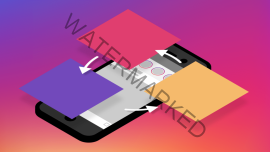Google Wallet appears in India, with local integrations, but Pay will stay | TechCrunch
Google Wallet will finally launch in India — nearly two years after its relaunch as a digital wallet platform in the U.S. — according to a preview of the app that the company accidentally posted on the Google Play store in the country.
After TechCrunch spotted the listing for the app — which will let users load up loyalty cards and buy things, among other features — the company declined to confirm that it will be coming soon to Android users. But it then appear to pull some of the details from the listing, such as what appear to be high-profile launch partners local to India. (The app now more generically features U.S. brands.)
Somewhat confusingly, Google did confirm to us that it will continue to run Google Pay as a standalone app in the country, at least for now. That’s a different strategy from just about every other market, where Google has been merging Wallet and Pay experiences together under a single Wallet app.
“While we don’t have anything new to share right now, we’re always working to bring more convenience to people’s digital experiences in India. We’re continuing to invest in the Google Pay app to give people easy, secure access to digital payments,” a Google spokesperson said in a statement to TechCrunch.
We understand that part of the reason seems to be that Google Pay is already massive in the country — it’s largely understood that India is Google’s largest market globally for payments, and it’s the second-largest payment app after PhonePe.
Not least because Google has confirmed its plans to continue to offer Google Pay as its payment service in India, the Indian version of Google Wallet is expected to differ from that of the U.S. For one, Google is looking to provide local integrations on the Wallet app in the country, which houses its biggest Android user base.
The Google Wallet listing that TechCrunch spotted last week featured screenshots of Indian airline Air India, state-owned bank State Bank of India and multiplex chain PVR Inox, suggesting that loyalty points can be picked up and used through these brands. (Shortly after TechCrunch reached out to Google for comment, Google updated the listing with U.S. brands.)
Image Credits: Google Play Store screenshots
The existing Google Wallet app is not available yet for download through the Play Store in India, but it has been working for some Android users in the country for some time, as reported by the Indian outlet Beebom. However, functionality is limited: users can add credit and debit cards for contactless payments, but the app does not support any Indian businesses and local loyalty programs.
These latest changes cap off a lot of bouncing Google has been doing between various financial services and differently-branded apps. Google Wallet was launched as the company’s payment solution way back in 2011. Then, Google launched Android Pay. Then, it tried to replace the Wallet and its Android Pay app with Google Pay. In 2022, Google relaunched the Wallet app as its digital wallet platform for Android, Wear OS and Fitbit OS. However, in February this year, the search giant announced it would replace Google Pay with the Wallet app in the U.S.
Unlike its U.S. version, Google Pay in India uses the Indian government-backed framework Unified Payments Interface (UPI) to enable payments. This is one reason why Google Pay is different in India, and also one reason why it might choose to continue giving users a separate option if they are already using it.
Google Pay is the second most used UPI app in India after Walmart’s PhonePe, giving Google an apparent reason to continue to support it while offering digital wallet-related experiences through the Wallet app. The Google Pay app initiated more than 5 billion transactions valued at over $83 billion in March, per the data posted by the UPI-parent organization National Payments Corporation of India.









